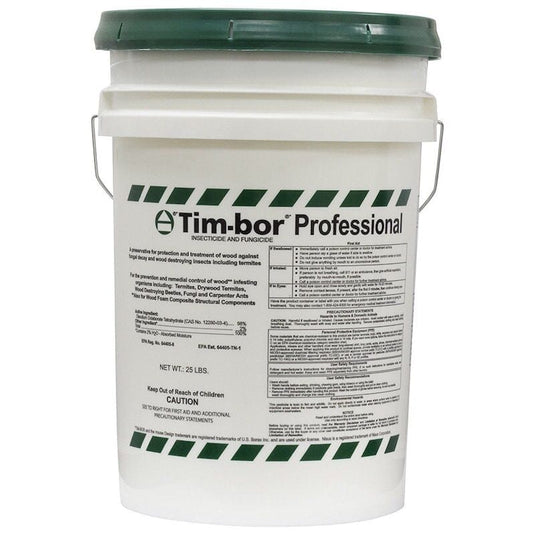Tim-bor Professional Insecticide and Fungicide Dust is a quick and proficient way to treat a structure for termites, drywood, carpenter ants, decay fungi and wood boring beetles. It can be consumed as a wood additive, fungicide and insect poison all alone or in conjunction with treatments as a supplement. As a result of its application flexibility as a liquid r dust, it can be applied as a spray, dust, mist or foam onto cellulose building materials, wood, or inside cracks, wall voids and crevices.
The active ingredient in Tim-Bor is a natural borate mineral salt with a low mammalian toxicity and has no known resistance. This active ingredient is known as Disodium Octaborate Tetrahydrate (DOT), a regular borate mineral salt and micro-supplement. It is made for use in the form of water-soluble borate powder. When it’s applied in a fluid structure by misting, spraying or foaming onto wood or other cellulosic materials, the borate ingredient makes a protective envelope and stays for years of protection.
DOT is a characteristic type of boron, which is vital for the solid development of plants and important in human calcium metabolism. Humans and animals simply take what they need from their diet and rapidly eliminate excess via the kidneys, DOT has a low acute toxicity. As a result, Tim-bor Professional is about half as toxic as sodium chloride or table salt (in a laboratory setting), but very operational against fungi and insects that do not have the same excretion mechanisms.
Features:
- Water-soluble borate powder for use as a foam, dust or liquid
- Active ingredient is a borate: Disodium Octaborate Tetrahydrate
- Won’t stain or discolor wood surfaces
- Can be specified for use as a replacement for fumigation or as an add-on to fumigation to provide residual protection
- Economical and highly effective
- Virtually odorless
- Won’t corrode nails, screws, and other components
- Controls and prevents wood decay fungi, carpenter ants, termites, powderpost beetles and old house borers
- For exterior and interior use
- Manufactured with a concern for the environment.
Target organisms: Tim-bor is an effective treatment for wood (and wood wood-foam composite structural components) to kill and prevent infestations of decay fungi including white rot, brownrot, (i.e. Poria) and wet rots.
Tim-bor is also effective for the prevention and control of:
Wood destroying insects such as, but not limited, to the following organisms:
- Subterranean Termites
- Dampwood Termites (Zootermopis)
- Drywood Termites (Kalotermes, Incisitermes)
- Powderpost Beetles (Lyctidae)
- Deathwatch and Furniture Beetles (Anobiidae)
- “False” Powderpost Beetles (Bostrichidae)
- Old House Borers, Longhorn Beetles (Cerambycidae)
- Bark and Timber Beetles (Scolytidae)
- Carpenter Ants (Camponotus)
- (Reticulitermes, Heterotermes, Coptotermes [Formosan])
Preparation of Treatment Solution:
10% Tim-bor Liquid Solution: To prepare solution, add approximately 80% of the required volume of water to the mixing vessel. While stirring, gradually add 1.0 pound of Tim-bor for each gallon of treating solution required. Add remaining water to the solution and stir until the entire product has dissolved.
15%Tim-bor Liquid Solution: Prepare solution as above, but gradually add 1.5 pounds of Tim-bor for each gallon of treatment solution needed. This solution should be use as soon as possible and not stored for an extended length of time.
15% Tim-bor Foam: Prepare a 15% liquid solution as described above and also add a surfactant-foaming agent. Generally 1-2 ounces of a foaming agent added to the 15%liquid solution will product a dry foam with the desired expansion ratio of approximately 20 to 1 (20 gallons of foam per 1 gallon of liquid solution). The Tim-bor foam should be of a “dry” consistency that adheres to wood surfaces so that run-off is minimized. A “wet” foam could damage wall board or other building components. It is also recommended to refer to the individual foam equipment manufacturer’s manual and th surfactant’s label for specific instructions.
Application:
Tim-bor as a liquid solution: Apply two application of a 10% solution to wood surfaces by brush or spray. Tim-bor liquid applications may be made to wood structures including decks, fences, steps, sheds, barns and other out-buildings. Tim-bor may be used as a liquid solution, a powder or a foam. Apply two applications of a 10% solution to wood surfaces by brush or spray. Apply one application of a 15% solution to wood surfaces by brush or spray. Application may also be made by drilling and then injecting the solution under pressure into sound wood or into the insect galleries of infested wood. Tim-bor may be applied as a foam to wood surfaces or injected into wall voids or insect galleries.
Tim-bor Professional Insecticide and Fungicide Dust is a quick and proficient way to treat a structure for termites, drywood, carpenter ants, decay fungi and wood boring beetles. It can be consumed as a wood additive, fungicide and insect poison all alone or in conjunction with treatments as a supplement. As a result of its application flexibility as a liquid r dust, it can be applied as a spray, dust, mist or foam onto cellulose building materials, wood, or inside cracks, wall voids and crevices.
The active ingredient in Tim-Bor is a natural borate mineral salt with a low mammalian toxicity and has no known resistance. This active ingredient is known as Disodium Octaborate Tetrahydrate (DOT), a regular borate mineral salt and micro-supplement. It is made for use in the form of water-soluble borate powder. When it’s applied in a fluid structure by misting, spraying or foaming onto wood or other cellulosic materials, the borate ingredient makes a protective envelope and stays for years of protection.
DOT is a characteristic type of boron, which is vital for the solid development of plants and important in human calcium metabolism. Humans and animals simply take what they need from their diet and rapidly eliminate excess via the kidneys, DOT has a low acute toxicity. As a result, Tim-bor Professional is about half as toxic as sodium chloride or table salt (in a laboratory setting), but very operational against fungi and insects that do not have the same excretion mechanisms.
Features:
- Water-soluble borate powder for use as a foam, dust or liquid
- Active ingredient is a borate: Disodium Octaborate Tetrahydrate
- Won’t stain or discolor wood surfaces
- Can be specified for use as a replacement for fumigation or as an add-on to fumigation to provide residual protection
- Economical and highly effective
- Virtually odorless
- Won’t corrode nails, screws, and other components
- Controls and prevents wood decay fungi, carpenter ants, termites, powderpost beetles and old house borers
- For exterior and interior use
- Manufactured with a concern for the environment.
Target organisms: Tim-bor is an effective treatment for wood (and wood wood-foam composite structural components) to kill and prevent infestations of decay fungi including white rot, brownrot, (i.e. Poria) and wet rots.
Tim-bor is also effective for the prevention and control of:
Wood destroying insects such as, but not limited, to the following organisms:
- Subterranean Termites
- Dampwood Termites (Zootermopis)
- Drywood Termites (Kalotermes, Incisitermes)
- Powderpost Beetles (Lyctidae)
- Deathwatch and Furniture Beetles (Anobiidae)
- “False” Powderpost Beetles (Bostrichidae)
- Old House Borers, Longhorn Beetles (Cerambycidae)
- Bark and Timber Beetles (Scolytidae)
- Carpenter Ants (Camponotus)
- (Reticulitermes, Heterotermes, Coptotermes [Formosan])
Preparation of Treatment Solution:
10% Tim-bor Liquid Solution: To prepare solution, add approximately 80% of the required volume of water to the mixing vessel. While stirring, gradually add 1.0 pound of Tim-bor for each gallon of treating solution required. Add remaining water to the solution and stir until the entire product has dissolved.
15%Tim-bor Liquid Solution: Prepare solution as above, but gradually add 1.5 pounds of Tim-bor for each gallon of treatment solution needed. This solution should be use as soon as possible and not stored for an extended length of time.
15% Tim-bor Foam: Prepare a 15% liquid solution as described above and also add a surfactant-foaming agent. Generally 1-2 ounces of a foaming agent added to the 15%liquid solution will product a dry foam with the desired expansion ratio of approximately 20 to 1 (20 gallons of foam per 1 gallon of liquid solution). The Tim-bor foam should be of a “dry” consistency that adheres to wood surfaces so that run-off is minimized. A “wet” foam could damage wall board or other building components. It is also recommended to refer to the individual foam equipment manufacturer’s manual and th surfactant’s label for specific instructions.
Application:
Tim-bor as a liquid solution: Apply two application of a 10% solution to wood surfaces by brush or spray. Tim-bor liquid applications may be made to wood structures including decks, fences, steps, sheds, barns and other out-buildings. Tim-bor may be used as a liquid solution, a powder or a foam. Apply two applications of a 10% solution to wood surfaces by brush or spray. Apply one application of a 15% solution to wood surfaces by brush or spray. Application may also be made by drilling and then injecting the solution under pressure into sound wood or into the insect galleries of infested wood. Tim-bor may be applied as a foam to wood surfaces or injected into wall voids or insect galleries.


